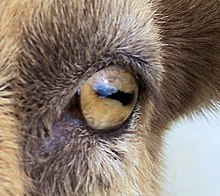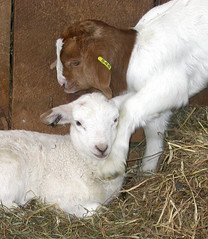I briefly mentioned goats in my last post,
in their capacity as surrogate spiders. (Researchers have genetically
engineered goats to produce spider silk protein in their milk.) I thought I
would develop the topic a bit, since they seem to crop up in all sorts of
unlikely places.
GOAT FACTS
A male goat is
called a billy or a buck. A female is called a nanny or a doe.
A buck will
urinate on his forelegs and face during mating season. Does find this
irresistible.
Apparently,
goats are “sensitive and intelligent” animals, for a given value of sensitive
and intelligent. According to this article,
animal intelligence is very hard to define, but abstract thinking,
problem-solving, reasoning, language, and the capacity for complex emotion
appear to play important roles.
Goats, in common
with many other hoofed animals, kangaroos, and, curiously, octopuses,
have eyes with horizontal, rectangular pupils. This gives them a visual field
of almost 360 degrees.
Life expectancy
for breeding does is 11-12 years. However, they can live up to 18 years
if they are retired from breeding when they are about 10.
Bucks only live
around 8-10 years, because going into rut (the crazed mating period – not a
uniquely human phenomenon) takes a lot out of them.
They have no
upper front teeth.
People who are
sensitive to cow’s milk can often tolerate goat’s milk.
GOATS ON BUSES
Anyone who has ever spent any amount of
time in Africa will be familiar with sights like this:
Well, how would you get your goats from A to B?
MEN WHO STARE AT GOATS
A wacky film about the “Jedi Knight” branch
of the US army. (The film stars Ewan McGregor – you may spot the unsubtle but
funny in-joke there.) The Jedi Knights – George Clooney and his buddies –
develop their psychic abilities for military use, and the definitive test is
being able to kill a goat by staring at it. The scene where a goat actually
drops down dead is, I am sorry to say, hilarious.
GOATS’ NAMES
From Equal Rites by Terry Pratchett:
Goats did have names for themselves, she
well knew; there was "goat who is my kid", "goat who is my
mother", "goat who is herd leader", and half a dozen other names, not least of which was "goat who is this goat." They had a
complicated herd system and four stomachs and a digestive system that sounded
very busy on still nights, and Granny had always felt that calling all this
names like Buttercup was an insult to a noble animal.
SEPARATING THE SHEEP FROM THE GOATS
GRATUITOUS CUTE PICURE OF BABY SHEEP AND BABY GOAT
This website gives a very helpful guide. Among its top tips are:
- The most obvious indication of whether an animal is a sheep or a goat is that is that a sheep’s tail hangs down while a goat’s tail goes up, unless it is sick or in distress. (I have to say this suprises me somewhat, since I always thought the most obvious indication was that sheep look like clouds with legs, while goats look like goats.)
- Sheep (Ovis Aries) have 54 chromosomes while goats (Capra Hircus) have 60.
- Occasionally (but only very occasionally), they interbreed. The offspring are not generally fertile.
- Sheep have a groove on their upper lip. Goats do not.
- Goats generally have horns. Sheep tend not to, but when they do, the horns are curlier than sheep’s.
PET NANNY GOATS
When I was
little, I had a book called The Children’s Encyclopedia, which used to belong
to my grandmother. I remember two things from it:
(1) Short picture stories, captioned in French, with word-for-word
English translations and then the translations rephrased into proper English. (At
the time, I didn’t quite understand the point of the exercise, and smirked at
what I thought was the outdatedness of “We see some droll of beds” and “The
cakes are good but I like better the ices”.)
(2) How to keep a nanny goat as a pet. Apparently, you have to build her
a house and give her lots of grass to eat, and she will reward you with milk
and affection.
GOATS IN TREES
I had the fortune recently to see a calendar full of pictures like this:
FAINTING GOATS
This breed of goat suffers from Thomsen’s Disease, meaning the goat’s muscles tense up and it keels over when startled. In the wild, this characteristic would have been done away with long ago – survival of the fittest, and all that – but in the agricultural context, it is actively bred in. Why?
I had the fortune recently to see a calendar full of pictures like this:
FAINTING GOATS
This breed of goat suffers from Thomsen’s Disease, meaning the goat’s muscles tense up and it keels over when startled. In the wild, this characteristic would have been done away with long ago – survival of the fittest, and all that – but in the agricultural context, it is actively bred in. Why?
1) Because the constant tensing up makes the muscles bulkier and
results in a higher meat-to-fat ratio, which makes for better meat.
2) Because it stops the goats escaping, because every time they try to
climb or jump over the fence, they faint.
3) Because in the past, fainting goats accompanied herds of sheep. If a
wolf or coyote attacked, the goat would keel over and get eaten, while the
sheep escaped.
4) Because it’s funny. It really is. Look at this video:
SO, WHAT HAVE WE LEARNT?
1) Urinating on your legs and face makes you irresistible.
2) I have just read the above sentence again, and I’m sure something is
wrong with it, but I can’t work out what.
3) Goats have a high IQ and rectangular pupils.
4) A goat will never walk when it can take the bus.
5) Goats keeling over are, unfortunately, a very funny sight.
6) Both sheep and goats have more chromosomes than you.
7) Never name a goat Buttercup.
8) There is no reason to stand on the ground when you can stand on a
tree.
9) Never underestimate a goat.
SOURCES
(As previously, feel free to click on some of these links. They are very interesting.)





